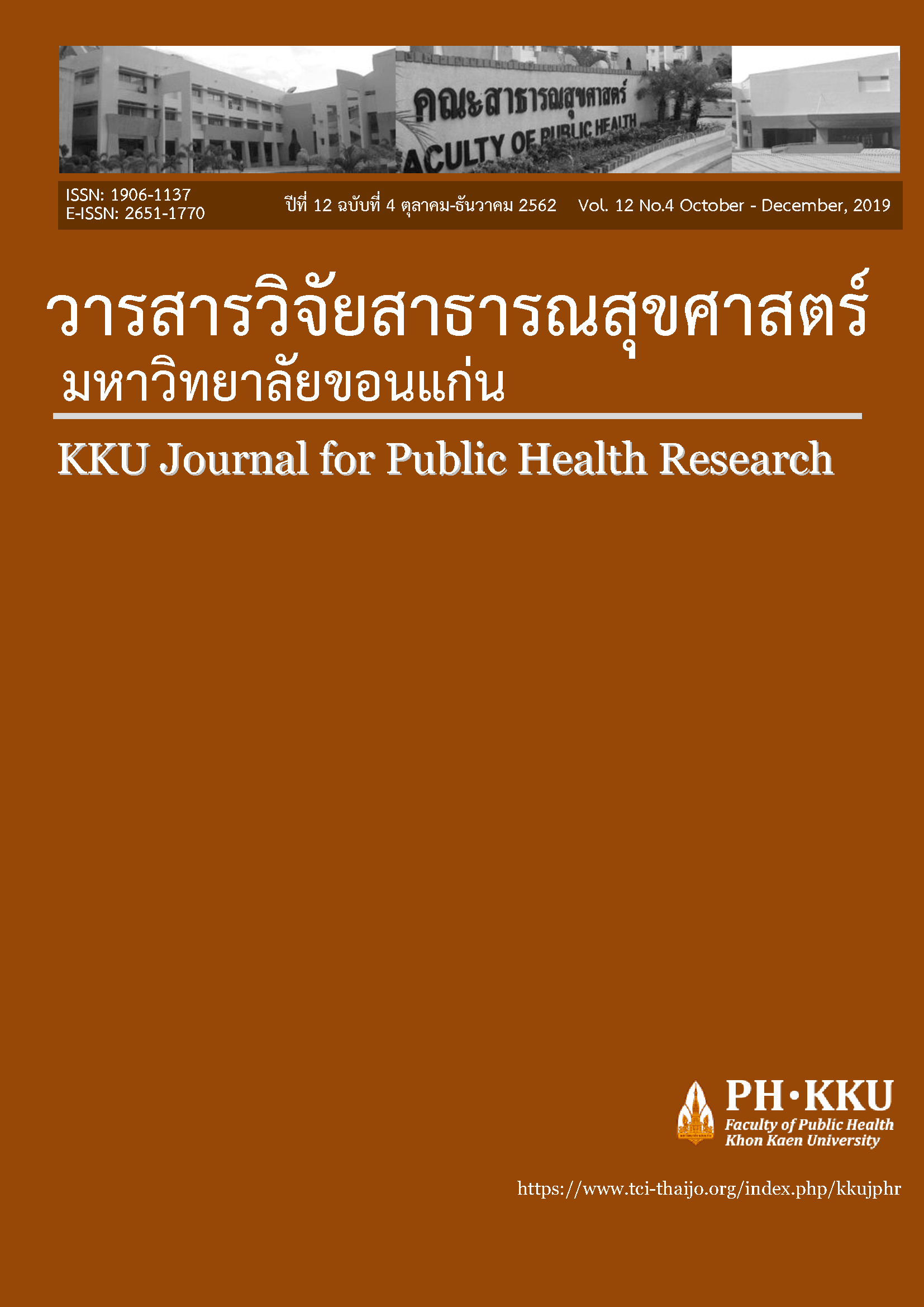Ergonomic Risk Assessment Tools and Postures During Lifting Tasks: A Systematic Research Review
คำสำคัญ:
งานยก, Rapid Entire Body Assessment, REBA, NIOSH lifting, โกนิโอมิเตอร์, คลื่นไฟฟ้ากล้ามเนื้อบทคัดย่อ
ปัจจัยเสี่ยงทางการยศาสตร์ เช่น การใช้ท่าทางที่ไม่เหมาะสม (Awkward posture) มีความสัมพันธ์กับการบาดเจ็บจากการทำงานและความเมื่อยล้าโดยเฉพาะอย่างยิ่งในงานยก การศึกษาครั้งนี้จึงมีวัตถุประสงค์เพื่อวิเคราะห์และสรุปรายงานการศึกษาที่ผ่านมาเกี่ยวกับท่าทาง เครื่องมือประเมินความเสี่ยงทางการยศาสตร์ และการทำงานของกล้ามเนื้อโดยใช้เครื่องตรวจวัดคลื่นไฟฟ้ากล้ามเนื้อ [Electromyography (EMG)] ในงานยก โดยทำการสืบค้นข้อมูลงานวิจัยที่ตีพิมพ์ในฐานข้อมูลอิเล็กทรอนิกส์ได้แก่ PubMed, Science Direct และ Health Science Journals หลังจากนั้นจึงนำผลการศึกษาที่ได้มาวิเคราะห์และสรุปเชิงเนื้อหา โดยแบ่งเป็น 4 ประเด็น ดังนี้ 1. เครื่องมือประเมินความเสี่ยงทางการยศาสตร์ในงานยกของพนักงานในโรงงานอุตสาหกรรม 2. ท่าทางในการยก 3. การประเมินท่าทางโดยใช้โกนิโอมิเตอร์ (Goniometer) และ 4. ภาระงานของกล้ามเนื้อในขณะทำงานยกโดยใช้เครื่องตรวจวัดคลื่นไฟฟ้ากล้ามเนื้อ (EMG) รายงานวิจัยที่ผ่านเกณฑ์ศึกษาจำนวน 20 เรื่องจากการค้นพบ 276 เรื่อง ผลการศึกษาพบว่า แบบประเมิน REBA และแบบประเมินความเสี่ยงงานยก NIOSH lifting equation ถูกใช้วิเคราะห์ความเสี่ยงทางการยศาสตร์ขณะทำงานยก ท่าทางการทำงานที่แตกต่างกันในขณะยกส่งผลต่อส่วนต่างๆ ของร่างกาย นอกจากนี้มียังพบการศึกษาในจำนวนที่น้อยเกี่ยวกับการประเมินท่าทาง และวิธีการศึกษาส่วนใหญ่ในการประเมินภาระงานของกล้ามเนื้อ คือ การใช้เครื่อง EMG ในการวิเคราะห์หาแรง (Force) และความล้า (Fatigue) ในขณะทำงานหรือหลังจากการปรับปรุงสถานีงาน การศึกษาในอนาคตควรเน้นในเรื่องการหาความสัมพันธ์ของการประเมินแบบรายงานด้วยตนเอง (Subjective assessment) หรือ การประเมินจากการสังเกต (Objective assessment) กับวิธีการวัดโดยตรง (Direct methods) เพื่อยืนยันผลการศึกษาในสภาพการทำงานยกที่เกิดขึ้นจริง
เอกสารอ้างอิง
Ahmad, I., & Kim, J. Y. (2018). Assessment of whole body and local muscle fatigue using electromyography and a perceived exertion scale for squat lifting. International Journal of Environmental Research and Public Health, 15(4), E784.
Al-Ashaik, R. A., Ramadan, M. Z., Al-Saleh, K. S., & Khalaf, T. M. (2015). Effect of safety shoes type, lifting frequency, and ambient temperature on subject's MAWL and physiological responses. International Journal of Industrial Ergonomics, 50, 43-51.
Antwi-Afaria, M. F., Lib, H., Edwardsc, D. J., Parnc, E. A., Seod, J., & Wonge, A. Y. L. (2017). Biomechanical analysis of risk factors for work-related musculoskeletal disorders during repetitive lifting task in construction workers. Automation in Construction, 83, 41–47.
Balasubramanian, K. R., Sivapirakasam, S. P., & Krishna, V. (2018). Fatigue evaluation in manual handling using surface EMG and ergonomic design of trolley. Ergonomics International Journal, 2(3), 145-154.
Behnoush, B., Tavakoli, N., Bazmi., E, Fard, F. N., Shahi, M. H. P., Okazi, A. et al. (2016). Smartphone and Universal Goniometer for Measurement of Elbow Joint Motions: A Comparative Study. Asian Journal of Sports Medicine, 7(2), 668-674.
Blache, Y., Allard, P., Plamondon A., & Begon, M. (2014). Effects of height and load weight on shoulder muscle work during overhead lifting task. Ergonomics, 58(5), 748-761.
Chowdhury, S. S., Boricha, J., & Yardi, S. (2012). Identification of awkward postures that cause discomfort to Liquid Petroleum Gas workers in Mumbai, India. Indian Journal of Occupational and Environmental Medicine, 16(1), 3-8.
Eungpinichpong, W., Buttagat, V., Areeudomwong, P., Pramodhyakul, N., Swangnetr, M., & Kaber, D., et al. (2013). Effects of restrictive clothing on lumbar range of motion and trunk muscle activity in young adult worker manual material handling. Applied Ergonomics, 44, 1024-1032. (In Thai).
Heebgaew, T., & Puttyangkura, N. (2016). A case study of ergonomic intervention in lifting task evaluated by using NIOSH Lifting Equation. In Ergonomics Society of Thailand. Proceedings Thailand National Ergonomics Conference 2016 (ErgoCon 2016). (pp. 183-192). Bangkok: Ergonomics Society of Thailand. (In Thai).
Hlavenka, T. M., Christner, V. F. K., & Gregory, D.E. (2017). Neck posture during lifting and its effect on trunk muscle activation and lumbar spine posture. Applied Ergonomics, 62, 28-33.
Kamnuengthamkhuncha, P., & Chantrasa, R. (2011). Design and improvement of work, work stations and environment in the processes of arc stack medium using ergonomics principle. In Faculty of Engineering, Rajamangala University of Technology Thanyaburi. IE Network Conference 2011. Bangkok: Faculty of Engineering, Rajamangala University of Technology Thanyaburi. (In Thai).
Luttmann, A., Jager, M., & Griefahn, B. (2003). Protecting Workers’ Health Series No 5. Germany: Institute for Occupational Physiology at the University of Dortmund.
Markdum, J., Thanasilp S., & Pudtong, N. (2017). The effects of a shoulder exercise program combined with qigong on ability to shoulder function of breast cancer patients after mastectomy. Songklanagarind Journal of Nursing, 37(1), 38-52. Thai.
Nazmi, N., Abdul Rahman, M. A., Yamamoto, S., Ahmad, S. A., Zamzuri, H., et al. (2016). A Review of Classification Techniques of EMG Signals during Isotonic and Isometric Contractions. Sensors, 16(8), 1-28.
Nimbarte, A. D., Aghazadeh, F., Ikuma, L. H., & Harvey, C. M. (2010). Neck disorders among construction workers: Understanding the physical loads on the cervical spine during static lifting tasks. Industrial Health, 48(2), 145-153.
Peolsson, A., Marstein, E., McNamara, T., Nolan, D., Sjaaberg, E., Peolsson M., et al. (2014). Does posture of the cervical spine influence dorsal neck muscle activity when lifting? Manual Therapy, 19(1), 32-36.
Poochada, W., & Chaiklieng, S. (2016). Risk assessment tools for identification of ergonomics factors on musculoskeletal disorders from investigations in static versus dynamic work. E-Journal of Safety and Environmental Reviews, 1(2): 1-7.
Punkub, K., Ratanaarporn L., & Wongthanasunthorn, N. (2010). Work Station Improvement for muscular fatigue reduction among female operators in handicraft mulberry paper. Kasetsart Engineering Journal, 73(23), 85-94. (In Thai).
Social Security Office, Thailand. (2018). Annual report 2018 of social security office. Retrieved October 23, 2018, from http://www. sso.go.th/wpr/uploads/uploadImages/file/AnnualRe¬portBook2561.pdf
Songsungnoen, N. & Pusapukdepob, J. (2013). Effectiveness of the Manual Lifting Workstation Improvement according to NIOSH Lifting Equation: a Case Study of an Automotive Parts Manufacturing Factory in Chonburi Province. Journal of Safety and Health, 6(21), 19-31. Thai.
Sungkhapon, A., Pochana K., & Auesujaridwong, W. (2013). Workstation improvement for risk reduction of muscular fatigue among production workers in tuna manufacturing process: a case study of a seafood processing factory. The Journal of KMUTNB, 23(3): 654-663. (In Thai).
Swann, E. (2012). Measurement in rehabilitation. In J. R. Andrews, G. L. Harrelson, & K. E. Wilk (Ed). Physical Rehabilitation of the Injured Athlete. (4th ed., pp. 67-73). Philadelphia: Elsevier.
Wang, Z., Wu, L., Sun, J., He, L., Wang, S., & Yang, L. (2012). Squat, stoop, or semi-squat: A comparative experiment on lifting technique. Journal of Huazhong University of Science and Technology, 32(4), 630-636.
Waters, T. R., Lu, M., Piacitelli, L. A., Werren, D., & Deddens, J. A. (2011). Efficacy of the revised NIOSH lifting equation to predict risk of low back pain due to manual lifting: Expanded cross-sectional analysis. Journal of Occupational & Environmental Medicine., 53(9), 1061-1067.
Wichai, J., & Chaiklieng, S. (2014). Ergonomics risk assessment among manual handling workers. KKU Research Journal, 19(5), 708-719. (In Thai).



